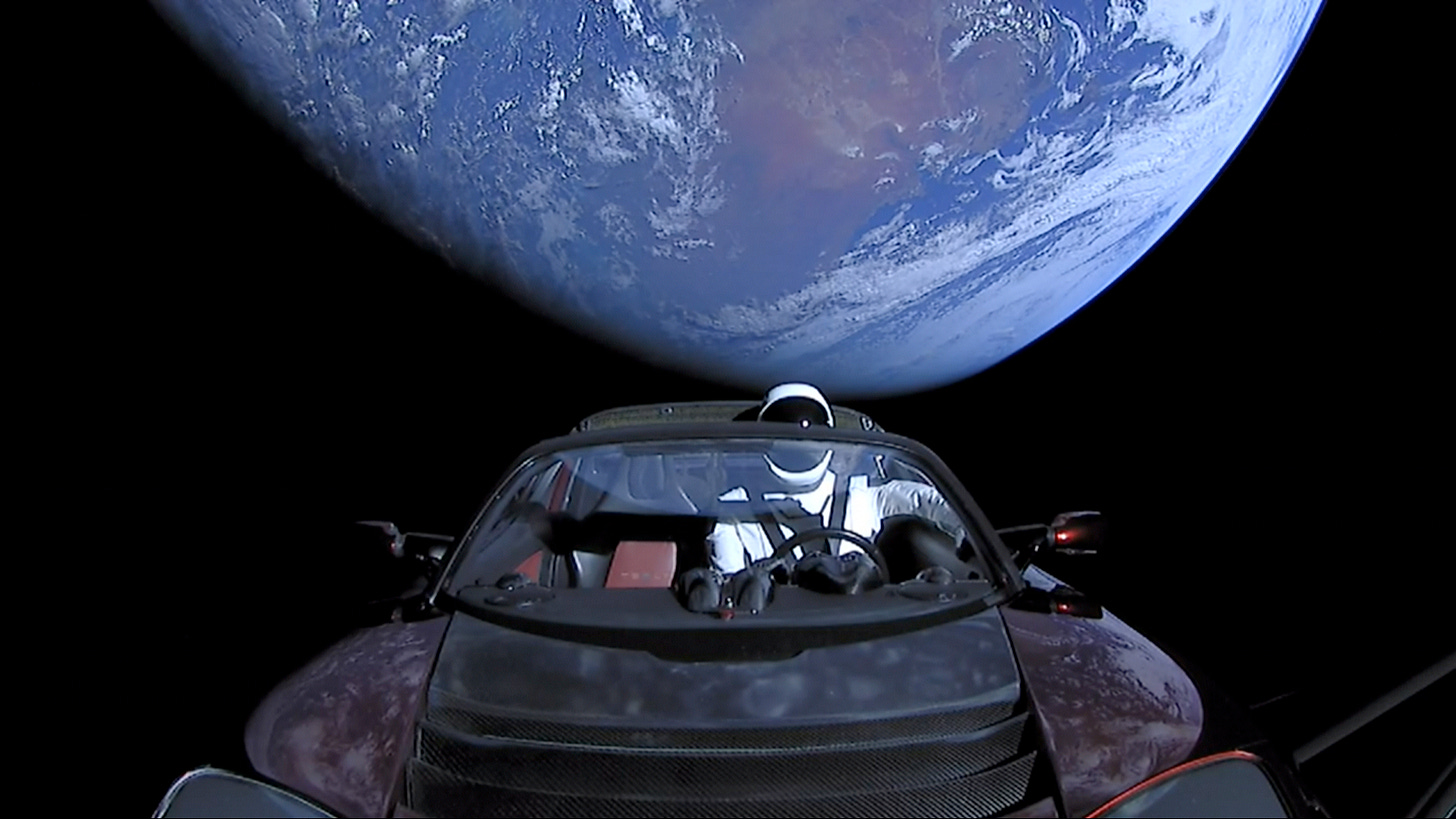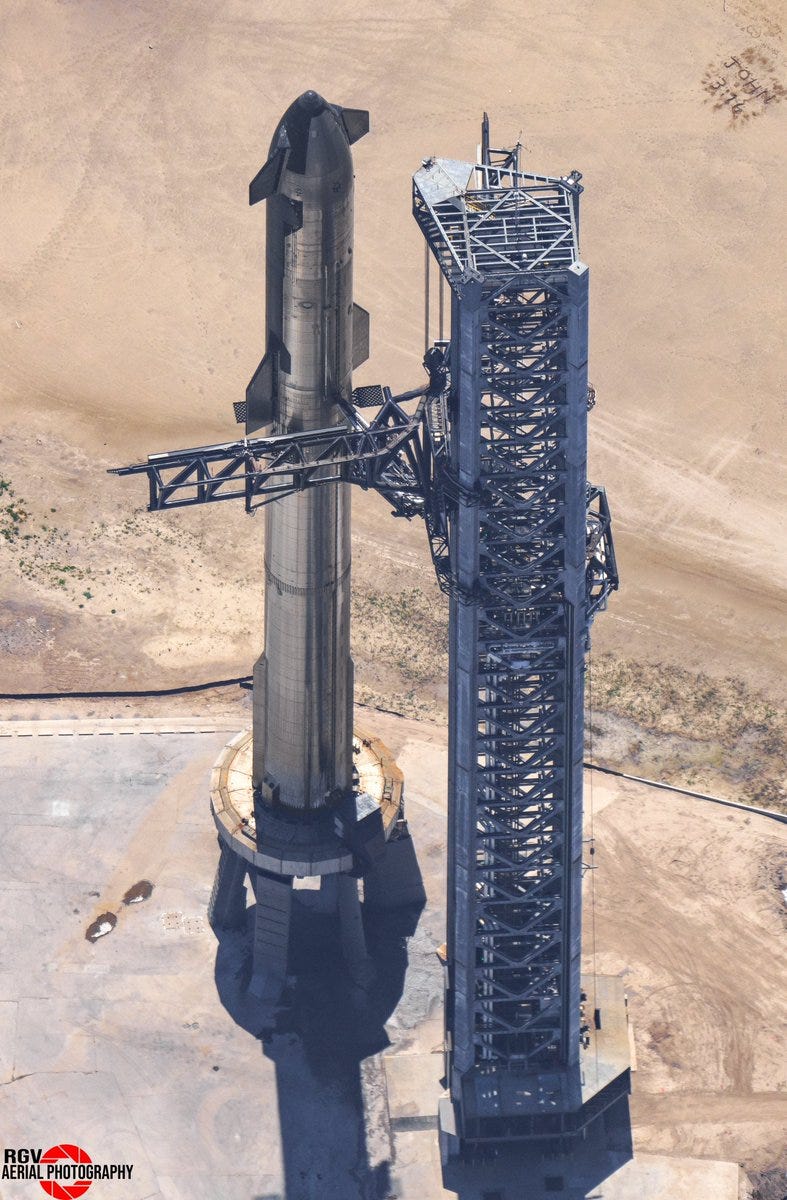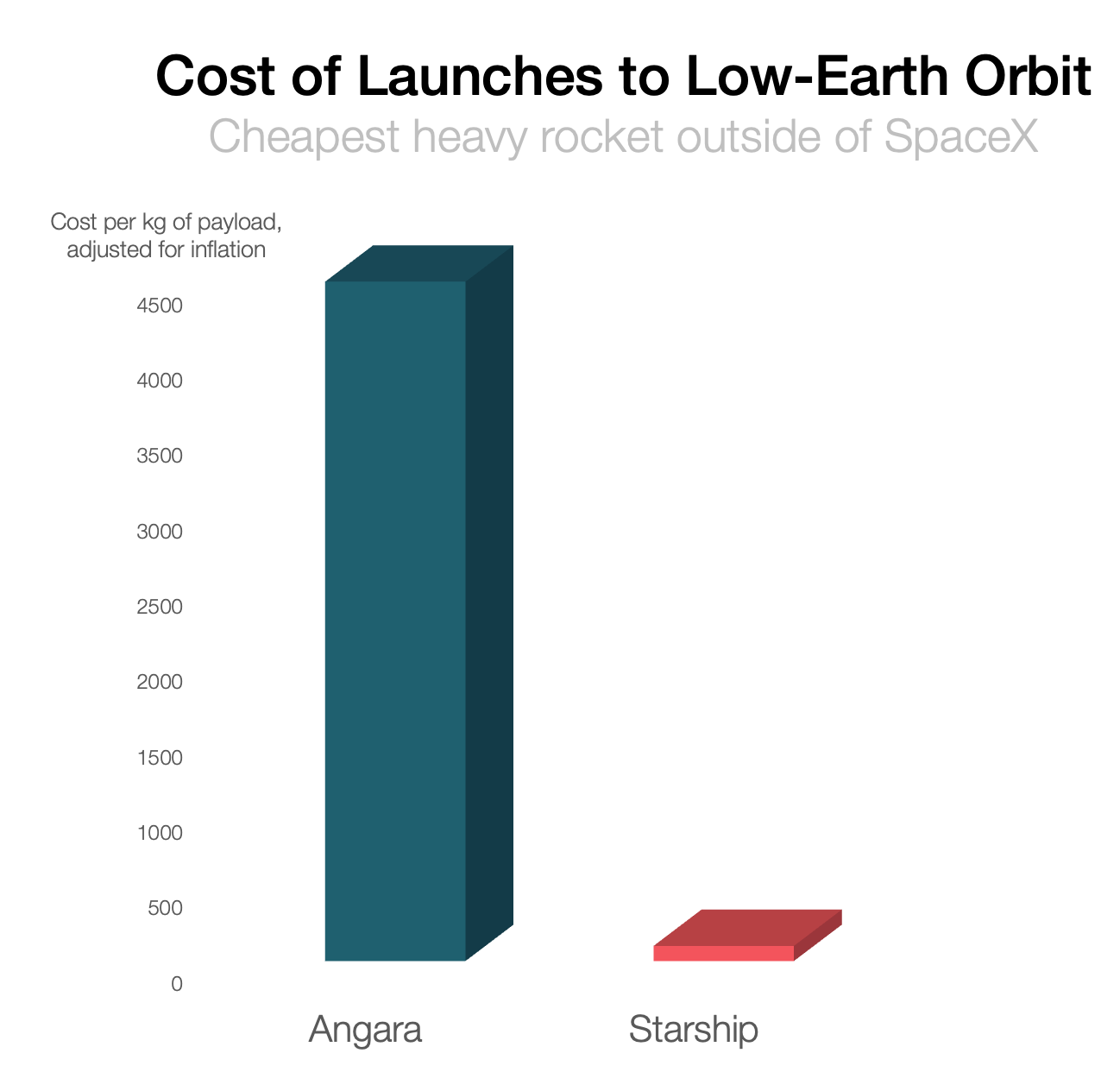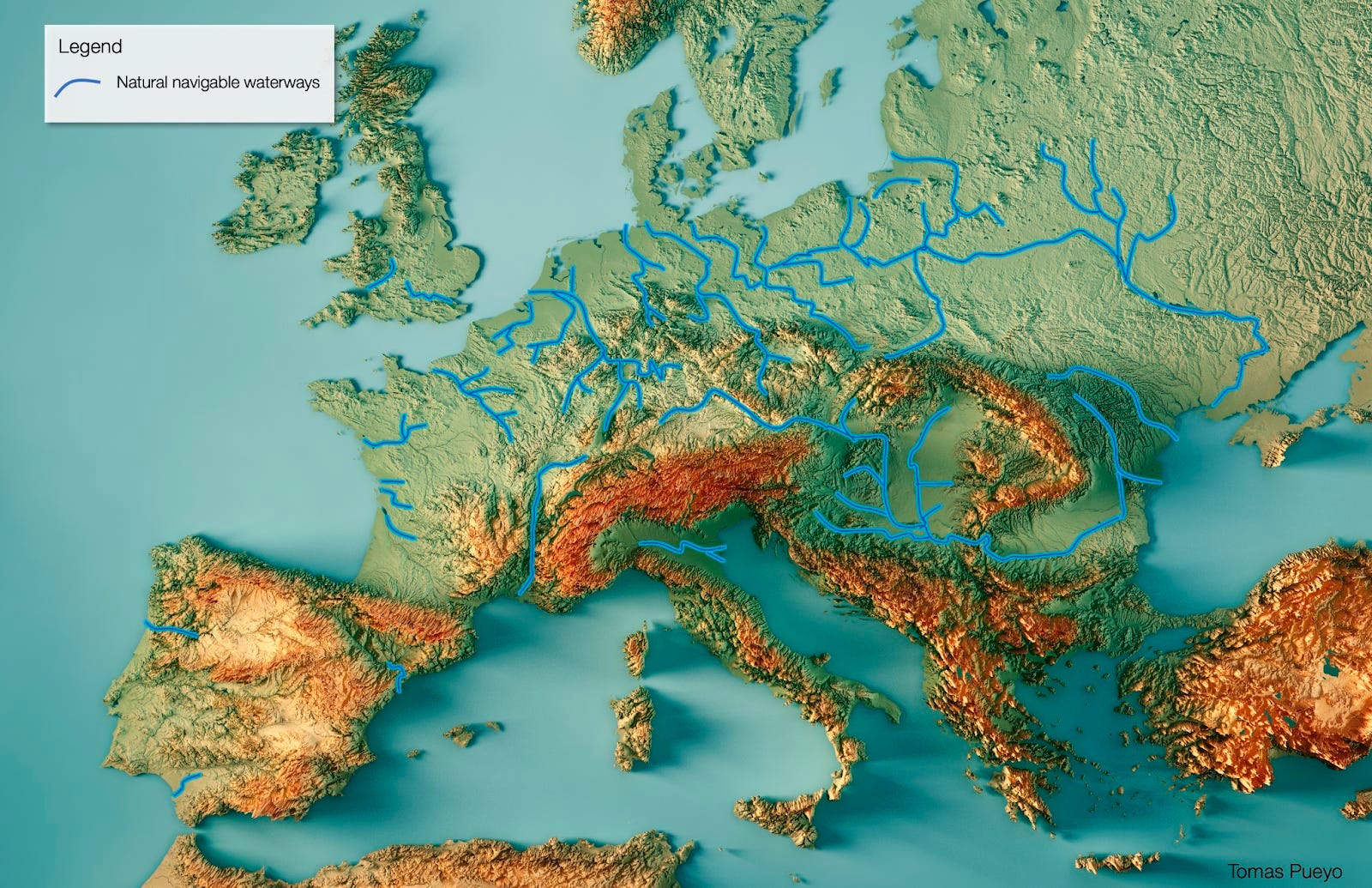Starship Will Change Humanity Soon
This is SpaceX’s new rocket: Starship.
It launched last week.
It did explode four minutes in:
But SpaceX will make it work. And when it does, what will matter is that it’s humongous.
It can carry so much payload to space that it will change the economics of space.
This will change civilization.
But we haven’t yet grasped how this will change civilization, both in space and on Earth. So let’s grasp it.
1. The Exponential Drop in Space Transportation Costs
In the last few years, the number of objects launched to space has skyrocketed.
In space, we mainly send things to Low-Earth Orbit, or LEO, the green area below:

We can send all these objects to LEO thanks to SpaceX’s reusable rockets. Each one of them can launch payloads to space dozens of times.
With all these launches, it’s not just the number of objects we can send to space that is soaring. Also the volume and mass. As a result, the cost to launch a kilogram of payload to LEO has dropped since the 1980s:

In the 1980s, it cost over $75k to carry one kilogram to space in a big rocket. Just carrying one astronaut’s body cost the astronomical sum of over $5M! SpaceX’s Falcon Heavy has brought it down to $1,500/kg, or 50 times cheaper. This is the magic of SpaceX’s bigger, reusable rockets.
Now SpaceX’s Starship rocket will take the baton and go farther. It is designed to carry over 100 tons of payload to LEO, which is 50% more than the latest Falcon heavy. It will have thousands of launches every year. And Elon Musk believes that within 2-3 years, the cost per kg will drop from Falcon Heavy’s $1,500 to $100.
To put it into perspective:
People don’t realize how big of a deal this is.
2. The Value of Cheap Transportation
Look at the cost of different types of transportation on Earth:
It’s no coincidence that the US and Northern Europe are two of the wealthiest regions in the world and also two of the regions with the most connected navigable inland waterways1.

Why does it matter? Because transportation costs over water are much cheaper than over land. And navigation through inland waterways is even better than sea transportation, because weather is much less of a problem, currents can be controlled, and rivers serve two banks instead of just one for coastal transportation.
You can see the value of rivers in a country like France, where the population density closely follows the river systems. Cheap transportation attracted people and wealth to the rivers, and especially to their confluences.

Why is that? Why did people gather around rivers?
Imagine you sell meat and can make a profit of $10 for each kilogram you sell. But it costs you $1 to transport each kg one kilometer. Each additional kilometer you add, your margin is reduced by $1. You can only transport your product 10 km away. In the example below, that means you can only trade with four cities:
If instead, your cost of transportation is half, what happens? It costs you $0.5 per km. Now you’re increasing your margins with each of the cities that you used to trade with. But more importantly, now you can reach markets that are 20 km away.
But when you 2x the distance, you 4x the surface! In this case, you can’t just trade with four cities anymore, you can trade with sixteen2! But according to Metcalfe’s law, the value of a network grows with the square of its nodes. Because now it’s not just your city that can connect to these sixteen other cities. Each one of these cities now can connect with sixteen other cities! All of them become richer, which means they can now buy more meat too.
This is what rivers do: by dropping the cost of transport, they connect huge numbers of cities, which can trade much more between them, become wealthier, their population can buy even more, and so on and so forth.
All in all, the value of the network to the right is at least an order of magnitude higher than that to the left! The cheaper the transport, the more trade at a lower cost, the more wealth generated, the more that wealth can be reinvested in better canals and bridges and roads, and the area’s wealth grows even further.
We’ve seen this through history. Rome was built around the Mediterranean’s cheap transportation costs, and obsessed about reducing overland transportation costs with their famous roads. Their empire was limited by the reach of their communications.

Similarly, the Egyptians lived around the Nile, the early Vikings around the North Sea, early Japan around its Seto Inland Sea, China started its canals in the 5th Century BC…
Transportation costs are so important they created empires.
Now Starship is dropping transportation costs to new worlds. What will that allow?
3. Change Minds, Change Organizations, Change the Worlds
Starship is like a conveyor belt to Low Earth Orbit (LEO). When you drop your transportation costs by 100x in a decade, a new universe of opportunities opens up so fast that human brains can’t follow.
Space engineers have spent decades focusing on shaving milligrams of weight off their satellites. The weight was so important that it pervaded every decision: cost structure, volumes to be sent, material choices, power sources, thermal protection, software for guidance, navigation, or control… Every aspect of the mission was obsessed about one thing: weight. Every NASA mission had to be a marvel of miniaturization to cram as much science as possible into every available micrometer. The obsession against mass was drilled into engineers’ brains, generation after generation.
That’s out the window.
All space missions, whether robotic or crewed, historical or planned, have been designed with constraints that are not relevant to Starship.
Starship obliterates the mass constraint and every last vestige of cultural baggage it has gouged into the minds of spacecraft designers. A dollar spent on mass optimization no longer buys a dollar saved on launch cost. It buys nothing. It is time to raise the scope of our ambition and think much bigger.—Casey Handmer, Starship is still not understood
In this light, it makes much more sense to have sent a Tesla Roadster to space.

It wasn’t simply an outrageous public relations move. It was a message to the rest of the industry: See how much you cared about every microgram? That time is gone. My rockets are so big that I can afford to send a Tesla and I barely notice. Anybody in the industry paying attention should have realized what was going on.
Most didn’t. For example, Artemis is an international program to send astronauts to the Moon, with the long-term goal of establishing a lunar base. But Artemis is designed with the old mindset, using the expendable Space Launch System rockets. If instead it used Starship, it could send 100x as much cargo and build a base for 1,000 astronauts in a year or two, instead of sending two or three dinky 10 ton crew habitats over the next decade. So why don’t we do that? Because Artemis is still trapped in a pre-Starship paradigm where each kilogram costs a million dollars and we must aggressively descope our ambition.
With a 100x decrease in cost and a 100x increase in transportation volume, space agencies can send 100x more payload to space for the same budget. How can the space economy saturate this new supply?
For example, prior to Starship, heavy machinery to build a Moon base could only come from NASA. After Starship, Caterpillar or Deere can qualify their existing products for space with very minimal changes. We could send crews to build a base in space with John Deere equipment in a few years, instead of waiting for decades while NASA engineers catch up with reality.
History is littered with the wreckage of former industrial titans that underestimated the impact of new technology and overestimated their ability to adapt: Blockbuster, Motorola, Kodak, Nokia, RIM, Xerox, Yahoo, IBM, Atari, Sears, Hitachi, Polaroid, Toshiba, HP, Palm, Sony, PanAm, Sega, Netscape, Compaq, GM…—Casey Handmer, Starship is still not understood
Everyone saw it coming, but senior management failed to recognize that adaptation would require stepping beyond the accepted bounds of their traditional business practice. If they don’t do it, others will for them.
4. The Possibilities of Starship
This is what Starlink is.
SpaceX created all this cheap cargo space and realized its ramifications before anybody else. They wondered: How can we use all this cheap cargo that nobody knows what to do with?
They looked at the most obvious business model to take advantage of it: satellite communications. They went for it. SpaceX created the satellite constellation Starlink, which provides fast, reliable Internet service all over the world. In many cases, the economics of beaming information down are superior to laying down cable on Earth. It’s already making money.
Starlink is just one example of what you can do with all this new, cheap cargo space. There are many more. The more time passes without companies realizing the opportunity, the more businesses SpaceX will gobble up.
What are some of these opportunities?
Today, we use satellite imaging, but the images you get from space are pretty stale, or not very detailed. We can get so much better. For example, there’s a thing called synthetic aperture radar, capable of capturing amazing pictures like this:

Have you ever used Google Maps and wondered: I’d love to see this, but in much more detail? Or what if I could see the Earth in real time? Or what if we could see an infrared image of the Earth in real time?
We could launch hundreds of satellites with such mind-blowing visual precision of the Earth that we would dramatically improve the accuracy of our meteorological models;
Our agriculture;
Where crime is happening;
Where poachers are operating in the savannah;
What’s happening with climate change;
Who is moving military personnel where…
Wouldn’t that be useful?
What if we all had access to real-time visualization of everything happening on Earth? How does that change businesses? How does that change society?
Please share your ideas on the types of businesses that this makes possible in the comments. I’m especially interested in the ramifications of real-time, detailed imagery of the world.
Conversely, I don’t think deep space is as viable. Tourism, deep-space mining, or Mars colonization are not businesses. This limits their potential a lot. I will cover this in the premium article this week
This article was inspired by and heavily quotes Casey Handmer’s blog, especially his post Starship is still not understood. I will be writing more about space in the coming weeks, and Casey’s blog has been a huge influence. I will also talk about Casey’s new venture in the future. Also thank you Chan Komagan for your ideas while writing this article, and Shoni as always for your edits!
Vietnam also has a high density of navigable inland waterways thanks to the Mekong and Red Rivers, but these are not connected, and are far away from each other, one in the north, the other in the south. Kazakhstan and Russia have a fair amount of inland navigable waterways, but most freeze in winter and discharge in the Arctic Ocean, so they can’t support a reliable economy. They’re also not connected to each other. Most of Brazil’s navigable rivers are in the Amazon, which is very poor economically. If you take out these exceptions where the inland navigable waterways are not connected, the top countries in terms of length of navigable waterways per km2 are, in this order, the Netherlands, Belgium, Germany, France, and the US.
Because the area covered is the square of the distance. Assuming the same density of cities, which in fact is an underestimation, because there are more people close to rivers thanks to better irrigation.













You are usually very healthily critical of things that are said by people. However, when it comes to Elon Musk, you seem to assume that whatever he says will be true. In this article you use one of his statements as proof that the price of the payload will drop to the level that Elon Musk says. I find this different treatment of sources quite dissonant.
Two things this article brings to mind. 1) Early U.S. we settled around the waterways for precisely the reasons you mention. In KY, for example, corn was converted to bourbon and ham so it would not spoil. Waterways were used to take them to market. Eventually railroads became transportation hubs and then population really began to disperse when the roads/automobiles came. 2) The discussion of weight and how engineers worked to make every ounce count reminds me of the early years of the microcomputer industry when programmers worked to make every bit of memory count. It was in short supply and thus you had to make efficient/effective use of every bit of memory available to you. Today that is not a problem and if you look at the code of many programs they are not efficiently written.